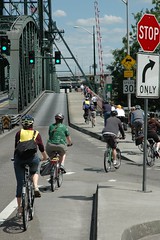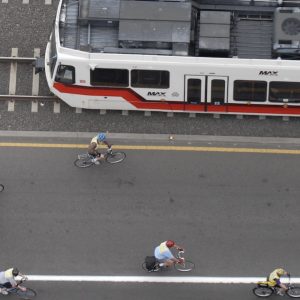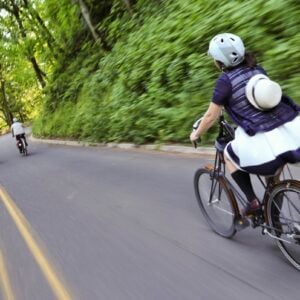
Steve Hymon.
One of the reasons some Portlanders take our bike policies so seriously and passionately (and are not shy about defending them) is because we realize that the microscope is on us. Portland is an important model that many other large cities look to (with even more urgency these days) when they want to learn how to manage, create, and foster a more bike-friendly urban environment.
The choices we make about bike planning here, reverberate far beyond the Portland city limits.
Earlier this week I shared a video about our bike parking facilities and policies that was shot by a film crew from New York City. And yesterday, a traffic and transportation columnist with The Los Angeles Times has published a story on his “Bottleneck Blog” titled, What can Portland teach Los Angeles about transportation?.
I always find it interesting to hear what visitors think about our bikeways, especially when its an expert pundit from a major city like Los Angeles. It’s also worth noting that while we’re impatiently clamoring for better conditions, people from most other major U.S. cities think Portland is bike nirvana.
Here are a few observations about biking in Portland from The LA Times’ “Road Sage” Steve Hymon (emphasis mine):
“…Portland transportation officials say that their own surveys show that actually 6% of the city’s residents are pedaling to work — tops in the nation for a large city.
I’d be skeptical of that number ordinarily. But on a Monday afternoon I sat on my rental bike watching the number of bike commuters heading out of downtown on the Hawthorne Bridge at rush hour. It was one bike after another on the bike lane on the bridge. Upon reaching the east side of the bridge, some cyclists used a special bike exit ramp to reach a bike path running along the Willamette. Amazing.”
The traffic on the Hawthorne these days makes it seem like our mode split is way beyond 6%!
“The funny thing about Portland is that the area really doesn’t have a tremendous number of miles of separated bike paths. Instead, the city has put bike lanes and routes on streets with lower volumes of traffic and emphasized connections.”
That’s an astute observation from a visitor, although I’ve heard recently that PDOT does have some interest in physically separated bike lanes (a.k.a. cycletracks).
“… I rented a bike on the northwest side of Portland. The city’s bike map helped me easily navigate to the riverfront bike path to the Hawthorne Bridge, which has bike lanes on both sides of it.
When a cyclist arrives at the east side of the Willamette River, the bike lane within several blocks peels off busy Hawthorne and instead puts cyclists on parallel residential streets. Again, there were plenty of signs and street markings. And, again, there were a ton of cyclists on the street going both directions..”
It’s nice to hear that a visitor was able to find their way from outside the tourist comfort zone of the riverfront. I talked about this with a USA Today travel reporter a few days ago (here’s the story she wrote) and I wasn’t sure if it would be a good idea to recommend that tourists venture out beyond the Esplanade.
“The funny thing is that many cities here have designated bike routes — you see those little green signs everywhere in Pasadena, for example. I think the difference in Portland is the emphasis on connectivity. It’s also a geographical and cultural thing. Commutes are shorter and residents clearly are into cycling.”
I like how Mr. Hymon seems to understand that such an important part of the bike momentum here in Portland is a “cultural thing.
“Cheryl Kuck, a spokesperson for the city’s transportation bureau, said that as more people have taken to biking, the city is mandated to keep spending money to keep improving facilities.
“If we have users at 4% to 6% or beyond [of all commuters], our capital budget has to create funds for that user group,” she said.”
Well, that would be great if it was actually true. There is no policy that mandates capital spending to be commensurate with mode split. It’s an idea that has come up before, but unfortunately it’s just an idea at this point.
— Check out more of Hymon’s observations (which include thoughts on our Light Rail, parking, Streetcar, and more) on his blog.







Thanks for reading.
BikePortland has served this community with independent community journalism since 2005. We rely on subscriptions from readers like you to survive. Your financial support is vital in keeping this valuable resource alive and well.
Please subscribe today to strengthen and expand our work.
nobody walks in LA
WOW! That guy has an eye for detail! I\’d love to someday hear that L.A. has become a Platinum winner too…
Keep up the good work Portland!
I used to bike commute through downtown LA. Out of fear I would take different routes through Chinatown and other parts of downtwon to hit the Metrolink at the main train station. I remember thinking it would be a great bike town if it was safer. I laugh at people in Portland who are fearful of the esplanade at night.
There are a suprising amount of awesome mountain bike trails all over the region. And on any friday night in the summer, people on bikes used to meet at the top of Mount Verdugo to watch the sunset. You never knew who would show up. Anyone from moutain bike hall of fame members (Joe Breeze and Steve Boemke) to 16 year olds on Kmart bikes.
Yesiree, LA does have a bike soul.
I hope Sam Adams & crew find a way to match transportation funding with our mode split (to the chagrin of flag-waving drivers). Its the only significant path to progress. I can\’t wait to cruise a cycletrack on some of our dangerous arterials. Everyone, especially motorists will benefit.
Matching expenditures with mode split is Sam\’s directive to PDOT. Watch for it in the next fiscal year.
…until it gets some resistance in which case we\’ll claim that gas tax revenue or something like that fell short of projections and then deep six the whole idea. Like the 405 crossing idea.
The problem with matching expenditures with mode split is gas tax appears to be the primary source of funding for transportation infrastructure, and the revenue decreases as more people bike.
Five vs. six vs. eight percent probably has little impact, but if ten or 15% of trips in the city are by bike, that will be a much bigger hit to transportation funding.
And why is gas tax at the fed, state and local level a flat amount per gallon, rather than a percentage? Using a percentage (like sales tax) would at least fix the problem of falling gas tax revenue as gas prices increase and people drive less, although it would not resolve the issue of falling revenue as more people bike (assuming funding split is tied to mode split). That issue can only be resolved by changing the tax base.
While Chris (#3) may scoff at the dangers on the Esplande at night I can attest to it
I ride early in the morning..like 3-5am early.. east bank to Sellwood Br. up till 2 weeks ago I would have agreed.
After having a 1.5\” pvc pipe broken across my back I\’ve changed my mind. When It didn\’t knock me off my bike they Ran.
a cracked separated rib & partially collapsed lung later..I bring protection.
Police did zero. Warm weather brings hoodlums by the droves.
I rode thru the LA area last year on my way to San Diego, I lived in S. Cal. 10 years stationed in the Marine Corps Air station El Toro. Most notable is how everything is spread out there.
They can get away with allowing cars to pass into bike lanes to turn . The blocks are so long in areas, there\’s plenty of room to merge bikes AND cars. That breeds another problem. Higher speeds of autos, & lesser attention by both bikes and cars.
Nothing allows your mind to wander like a long straight stretch.
If any Metro area needs seperated bike lanes and paths, it\’s LA.
Funding for it\’s putting the cart before the horse.
First they need to investigate HOW they would first implement a system to transverse the spans around the area.
LA needs both rail/articulated bike friendly transit..AND an arterial system of bike routes. it\’s far too big an area.
Portland\’s Max + boulevard system for bikes is very efficient. I can jump on Max with my bike and travel 10mi in either direction to Hillsboro or Gresham, AND exit along the way to head north and south along routed boulevards
I can ride SE along riverfront
I can ride NW along hwy 30
I can ride NE along Marine DR.
I can ride SW along 99W
This creates a grid for the city..much like highway systems did for early America.
throwing the Max in, creates an efficient commute.
If Max would give special attention to bikes traveling from Sunset TC to goose hollow, I\’m sure there\’d be even more
Some sort of \”Mountain only\” pass system for cyclists
The reason why the rest of us neanderthals think PDX is biking nivirna is not really because of the bike lanes, aka suicide lanes, the bike boxes, aka idiot boxes, or even the lack of adequate bike parking.
PDX is biking nirvirna simply because of a whole lot of bikers doing some pretty crazy stuff. Bikers doing crazy stuff can be done just about anywhere. There just not the critical mass out here in the sticks.
Actually, L.A. really not that bad. I take great pleasure in pissing off impatient movie moguls on Ventura Blvd., criminally speeding just catch the next red. That uphill stretch on Sunset Blvd from WeHo to UCLA is a piece of cake, if just you get in FRONT of the jags. Make \’em see ya.
All L.A. needs to do is just slow down the traffic.
Steven #8, I\’m sorry if my comment marginalized your pain. I menat to point out that relativly sopeaking, PDX is a safer place than most.
And Paul, I think you are A#1 spot-on in noting the true reason that PDX is bike Nirvana. Despite less than optimal weather, alot of people with a deep passion for bikes live here. Period.
As I have said in other posts, I feel this basic concept is in danger of being a victim of it\’s own success. If the city does split tax expenditures to reflect mode split, I predict a signifigant backlash to bikes in this city. And since the usefulness of the added infrastructure is questionable to many of us, the net change from a split would by negative.
I was interested to note the comments about the fact we subsidize transit where in LA its got to be self sufficient. I am not sure I agree with the idea that we subsidize transit that much.. i just dont have the numbers. It seems to me that what passes for subsidy is often a shifting of dollars. Should I decide to use transit or ride my bike downtown, i spare myself the cost of maintaining and operating a car. I miss the parking costs. So I probaby have more money to spend on other things. Money has a ring of influence ( the money i spend at a resturant goes to a waiter to pays rent, a bakery for supplies,etc.) Kept local, that dollar exerts a lot of influence. All by riding the bus or biking. So.. is that money spent to build a transit system a subsidy or an investment?
I do know that a dollar not spent on fossil fuels stays in the US a lot longer. Investing in transit/ alt.transit makes more sense than buiding more roads.
CRC Sam is promising more bike stuff, and I\’m not holding my breath. Meanwhile, there\’s another wasteful sting going on today by our friends in the PPB. If we had real leadership in this town, we\’d have way more than 6% mode split.
joe adamski:
Don\’t forget the extent that the highway system is subsidized when you are calculating transit subsidies. In addition to all the construction and maintenance costs, there are externalities like all the extra inefficiencies in communities having to provide services (utilities, water, sewer, police, etc) to extremely low-density housing, which is a direct result of sprawl-promoting road construction, which are not all borne by the developers. Also, there\’s the little matter of our bizarre foreign policy, the ultimate expression of the phenomenon of the public bearing the cost (lives and money) and private corporations (oil, defense, etc) raking in the profits.